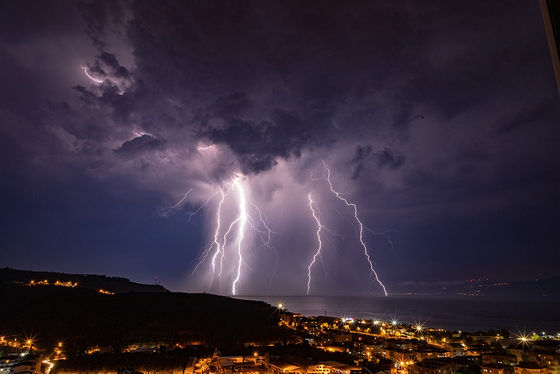End-of-the-world photo with 100 lightning bolts

Turkish astrophotographer Uğur İkizler took a 50-minute time-lapse of a severe thunderstorm in Turkey and released a photo of more than 100 lightning bolts in one.
Mudanya Gökyüzünde Gecenin Aydınlığı – ikizler.org – Uğur İkizler
Electrifying time-lapse image captures 100 lightning bolts torching the sky over Turkey | Live Science
https://www.livescience.com/planet-earth/weather/electrifying-time-lapse-image-captures-100-lightning-bolts-torching-the-sky-over-turkey
This picture was taken by Mr. İkizler in the coastal city of Mudanya in the northwestern part of Turkey, near his home. The fact that more than 100 lightning bolts were captured in the 50-minute shooting from 23:00 on June 16, 2023 local time means that lightning occurred at an average rate of once every 30 seconds. increase.
View this post on Instagram
İkizler told Live Science, a scientific news media that picked up this photo, ``The thunderstorm was a spectacular visual spectacle. It was a terrifying sight,' he said.
The lightning seen in this photo can be broadly classified into three types. The first is ``cloud-to-cloud'' that discharges in the clouds, the second is ``cloud-to-ground'' that falls to the land, and the third is not on land but on water It's a 'cloud-to-water' that falls into the water.
Mr. İkizler has also published pictures that are not time lapses, and even a single thunder is quite powerful.

In fact, it is not uncommon for a severe thunderstorm to have many lightning strikes. According to Live Science, there are 1.4 billion lightning strikes per year in the world, about 3 million times per day, which is calculated as 44 lightning strikes per second.
It is said that the voltage of a lightning strike is 100 million to 1 billion volts and the current is billions of amperes, and with this amount of energy it is possible to raise the ambient temperature by 10,000 to 33,000 degrees. By comparison, the surface temperature of the Sun is only about 5500 degrees.
Also, in Mr. İkizler's photo, you can see that the lightning bolt draws a characteristic zigzag trajectory. In fact, we don't know exactly what causes lightning to take on this shape, but

Related Posts:
in Science, Posted by log1l_ks







